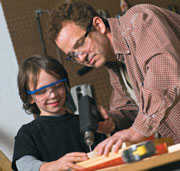Children’s Eye Injuries: Prevention and Care
When children participate in sports, recreation, crafts or home projects, it’s important for them to know eye safety practices and use protective glasses as appropriate. Each year thousands of children sustain eye damage or even blindness from accidents at home, at play or in the car. More than 90 percent of all eye injuries can be prevented through use of suitable protective eyewear.
Sports deserve particular attention, because eye injuries occur fairly often in children and young adult athletes: between the ages of five and 14, most sports-related injuries in the U.S. occur while playing baseball. Learn more about eye injuries and prevention.
Preventing Injuries
- Children should wear sports eye protectors made with polycarbonate lenses for baseball, basketball, football, racquet sports, soccer, hockey, lacrosse, paintball.
- All chemicals and sprays must be kept out of reach of small children.
- Parents and others who provide care and supervision for children need to practice safe use of common items that can cause serious eye injury, such as paper clips, pencils, scissors, bungee cords, wire coat hangers and rubber bands.

- Teach your children to be EyeSmart by safeguarding your own sight with ANSI-approved protective eyewear during potentially dangerous yard work and household repairs or projects.
- Only purchase age-appropriate toys.
- Avoid projectile toys such as darts, bows and arrows, and missile-firing toys.
- Look for toys marked with "ASTM", which means the product meets the national safety standards set by the American Society for Testing and Materials.
- Use safety gates at the top and bottom of stairs. Pad or cushion sharp corners. Put locks on all cabinets and drawers that kids can reach.
- Do not allow your children to play with non-powder rifles, pellet guns or BB guns. They are extremely dangerous and have been reclassified as firearms and removed from toy departments.
- Do not allow children anywhere near fireworks, especially bottle rockets. These fireworks pose a serious risk of eye injury and have been banned in several states.
- When very small children (age 4 and younger) are bitten by dogs, eye injuries occur about 15 percent of the time. The dog is usually one the child is familiar with, and second attacks by the same dog are likely to cause more serious injury. It is recommended that any dog that bites a child be removed from the household.
- On the road, make sure children are properly secured in baby carriers and child safety seats and that the seat and shoulder belts fit well. Children age 12 and younger should never ride in the front seat. Store loose items in the trunk or secured on the floor, as any loose object can become a dangerous projectile in a crash.
First Aid
An ophthalmologist, primary care doctor, school nurse or children’s health service should examine the eye as soon as possible, even if the injury seems minor at first, as a serious injury is not always immediately obvious. Delaying medical attention can cause the damaged areas to worsen and could result in permanent vision loss or blindness.
While seeking medical help, care for the child as follows:
- DO NOT touch, rub or apply pressure to the eye.
- DO NOT try to remove any object stuck in the eye. For small debris, lift eye lid and ask child to blink rapidly to see if tears will flush out the particle. If not, close the eye and seek treatment.
- Do not apply ointment or medication to the eye.
- A cut or puncture wound should be gently covered.
- Only in the event of chemical exposure, flush with plenty of water.